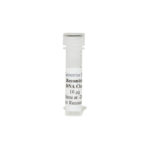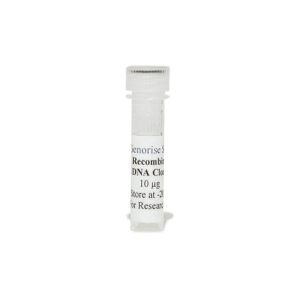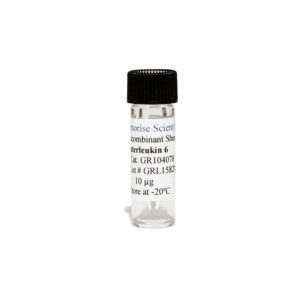Recombinant Canine NGF-B Protein
$99.00 – $2,280.00
The recombinant canine NGF-B protein is derived from in vivo expression of canine NGF-B gene in E. coli and purified using his-tag affinity column and can be used in multiple applications such as cell culture, ELISA and western blot.
Alternative names for NGF-B: Nerve growth factor, beta-NGF, NGF, NGFB, beta-HSAN5.
This product is for Laboratory Research Use Only not for diagnostic and therapeutic purposes or any other purposes.
- Description
- Product Citations
- Reviews (0)
Description
Genorise Recombinant Canine NGF-B Protein Summary
Alternative names for NGF-B: Nerve growth factor, beta-NGF, NGF, NGFB, beta-HSAN5.
Alternative name for canine: Dog
Product Specifications
| Purity | > 97%, by SDSPAGE under reducing conditions and visualized by silver stain. |
| Endotoxin Level | < 0.1 EU per 1 μg of the protein by the LAL method. |
| Activity | Measured in a cell proliferation assay using TF-1 human erythroleukemic cells. |
| Source | E. coli derived canine NGF-B. |
| Accession # | NP_001181879.1 |
| N-Terminal Sequence Analysis | Met |
| Amino Acid Sequence | Ser122-Ala241 |
| Predicted Molecular Mass | 14 kDa |
| SDS-PAGE | 14 kDa, reducing conditions |
Background:
Nerve growth factor (NGF) is a neurotrophic factor and neuropeptide primarily involved in the regulation of growth, maintenance, proliferation, and survival of certain target neurons. NGF also plays crucial roles in the survival of pancreatic beta cells and the regulation of the immune system. NGF is produced as proNGF in a 7S, 130-kDa complex of 3 proteins – Alpha-NGF, Beta-NGF (NGF-B), and Gamma-NGF (2:1:2 ratio) when expressed. The gamma subunit of this complex acts as a serine protease and cleaves the N-terminal of the beta subunit into functional NGF (NGF-B). The term NGF usually refers to the 2.5S, 26-kDa beta subunit of the protein, the only component of the 7S NGF complex that is biologically active. NGF binds with at least two classes of receptors: TrkA and LNGFR/p75NTR. [1][2] NGF can promote bcl-2 gene expression by binding to the TrkA, which stimulates the proliferation and survival of the target neuron. High affinity binding between proNGF, sortilin, and p75NTR can result in either survival or programmed cell death (PCD). Studies show that superior cervical ganglia neurons that express both p75NTR and TrkA die when treated with proNGF,[1]while NGF treatment of these same neurons results in survival and axonal growth. Survival and PCD mechanisms are mediated through adaptor protein binding to the death domain of the p75NTR cytoplasmic tail. NGF expression may be stimulated by DHEA[3] and ACTH. The expression of NGF is increased in inflammatory diseases where it suppresses inflammation.[4] NGF appears to promote myelin repair. NGF is involved in various psychiatric disorders. Dysregulation of NGF signaling has also been linked to Alzheimer’s disease.[5] NGF has been shown to play a role in cardiovascular diseases.[6] Reduced plasma levels of NGF and BDNF have been associated with acute coronary syndromes and metabolic syndromes.[7]
References
1. Lee R, et al. (Nov 2001). Science. 294 (5548): 1945–8.
2. Nykjaer A, et al. (2004). Nature. 427 (6977): 843–8.
3. Rahmani A, et al. (2011). Advances in Pharmacological Sciences. 2013: 506191.
4. Freund V, Frossard N (2004). Progress in Brain Research. 146: 335–46.
5. Counts SE, et al. (2005). J Neuropathol Experimental Neurol. 64 (4): 263–72.
6. Chaldakov GN, et al. (2004). Progress in Brain Research. 146: 279–89.
7. Manni L, et al. 2005). International Journal of Cardiology. 102 (1): 169–71.
Product Citations
Be the first to review “Recombinant Canine NGF-B Protein”
You must be logged in to post a review.





























Reviews
There are no reviews yet.